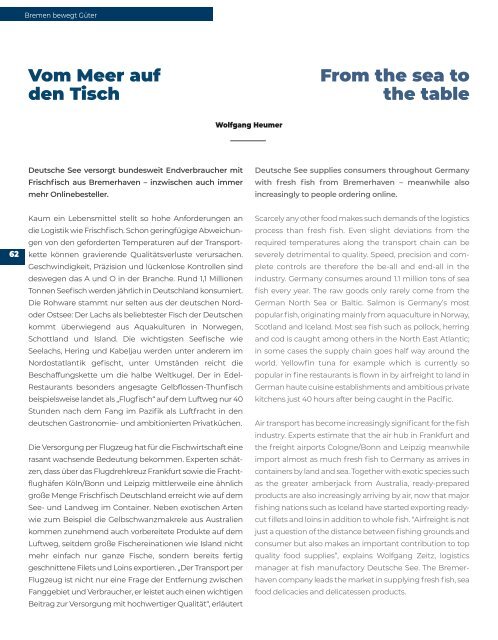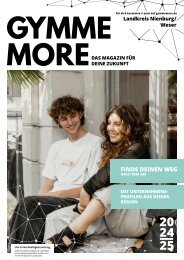Bremen bewegt 2019
Sie wollen auch ein ePaper? Erhöhen Sie die Reichweite Ihrer Titel.
YUMPU macht aus Druck-PDFs automatisch weboptimierte ePaper, die Google liebt.
<strong>Bremen</strong> <strong>bewegt</strong> Güter<br />
Vom Meer auf<br />
den Tisch<br />
From the sea to<br />
the table<br />
Wolfgang Heumer<br />
Deutsche See versorgt bundesweit Endverbraucher mit<br />
Frischfisch aus Bremerhaven – inzwischen auch immer<br />
mehr Onlinebesteller.<br />
Deutsche See supplies consumers throughout Germany<br />
with fresh fish from Bremerhaven – meanwhile also<br />
increas ingly to people ordering online.<br />
62<br />
Kaum ein Lebensmittel stellt so hohe Anforderungen an<br />
die Logistik wie Frischfisch. Schon geringfügige Abweichungen<br />
von den geforderten Temperaturen auf der Transportkette<br />
können gravierende Qualitätsverluste verursachen.<br />
Geschwindigkeit, Präzision und lückenlose Kontrollen sind<br />
deswegen das A und O in der Branche. Rund 1,1 Millionen<br />
Tonnen Seefisch werden jährlich in Deutschland konsumiert.<br />
Die Rohware stammt nur selten aus der deutschen Nordoder<br />
Ostsee: Der Lachs als beliebtester Fisch der Deutschen<br />
kommt überwiegend aus Aquakulturen in Norwegen,<br />
Schottland und Island. Die wichtigsten Seefische wie<br />
Seelachs, Hering und Kabeljau werden unter anderem im<br />
Nordostatlantik gefischt, unter Umständen reicht die<br />
Beschaffungskette um die halbe Weltkugel. Der in Edel-<br />
Restaurants besonders angesagte Gelbflossen-Thunfisch<br />
beispielsweise landet als „Flugfisch“ auf dem Luftweg nur 40<br />
Stunden nach dem Fang im Pazifik als Luftfracht in den<br />
deutschen Gastronomie- und ambitionierten Privatküchen.<br />
Die Versorgung per Flugzeug hat für die Fischwirtschaft eine<br />
rasant wachsende Bedeutung bekommen. Experten schätzen,<br />
dass über das Flugdrehkreuz Frankfurt sowie die Frachtflughäfen<br />
Köln/Bonn und Leipzig mittlerweile eine ähnlich<br />
große Menge Frischfisch Deutschland erreicht wie auf dem<br />
See- und Landweg im Container. Neben exotischen Arten<br />
wie zum Beispiel die Gelbschwanzmakrele aus Australien<br />
kommen zunehmend auch vorbereitete Produkte auf dem<br />
Luftweg, seitdem große Fischereinationen wie Island nicht<br />
mehr einfach nur ganze Fische, sondern bereits fertig<br />
geschnittene Filets und Loins exportieren. „Der Transport per<br />
Flugzeug ist nicht nur eine Frage der Entfernung zwischen<br />
Fanggebiet und Verbraucher, er leistet auch einen wichtigen<br />
Beitrag zur Versorgung mit hochwertiger Qualität“, erläutert<br />
Scarcely any other food makes such demands of the logistics<br />
process than fresh fish. Even slight deviations from the<br />
required temperatures along the transport chain can be<br />
severely detrimental to quality. Speed, precision and complete<br />
controls are therefore the be-all and end-all in the<br />
industry. Germany consumes around 1.1 million tons of sea<br />
fish every year. The raw goods only rarely come from the<br />
German North Sea or Baltic. Salmon is Germany’s most<br />
popular fish, originating mainly from aquaculture in Norway,<br />
Scotland and Iceland. Most sea fish such as pollock, herring<br />
and cod is caught among others in the North East Atlantic;<br />
in some cases the supply chain goes half way around the<br />
world. Yellowfin tuna for example which is currently so<br />
popular in fine restaurants is flown in by airfreight to land in<br />
German haute cuisine establishments and ambitious private<br />
kitchens just 40 hours after being caught in the Pacific.<br />
Air transport has become increasingly significant for the fish<br />
industry. Experts estimate that the air hub in Frankfurt and<br />
the freight airports Cologne/Bonn and Leipzig meanwhile<br />
import almost as much fresh fish to Germany as arrives in<br />
containers by land and sea. Together with exotic species such<br />
as the greater amberjack from Australia, ready-prepared<br />
products are also increasingly arriving by air, now that major<br />
fishing nations such as Iceland have started exporting readycut<br />
fillets and loins in addition to whole fish. “Airfreight is not<br />
just a question of the distance between fishing grounds and<br />
consumer but also makes an important contribution to top<br />
quality food supplies”, explains Wolfgang Zeitz, logistics<br />
manager at fish manufactory Deutsche See. The Bremer -<br />
haven company leads the market in supplying fresh fish, sea<br />
food delicacies and delicatessen products.


















